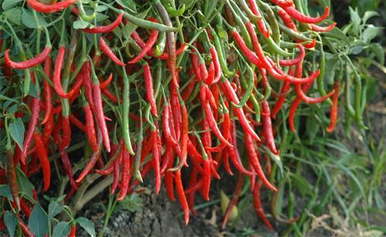Chilli
Chilli is a commercial crop grown in India. It is used in India as principle ingredient in Indian cuisine. Chilli is valued principally for its high pungency and colour. India is the world’s biggest producer, consumer and exporter of chili.
Though chilli is grown in almost all the States of India, mostly it is grown in Andhra Pradesh (46%), Karnataka (15%), Maharashtra, Madhya Pradesh, Orissa, West Bengal, Rajasthan and Tamil Nadu. Indian Chilli can be grown during the entire year in one or the other part of the country.

It grows on a wide variety of soils in tropical and sub-tropical climate with warm and humid weather condition. Though, Chilli is grown in different soils, black soils are suitable for rain fed crop while well drained soils, delta soils and sandy loams are better suited for irrigated crop.
Chilli is cultivated in India in both Kharif and Rabi crop seasons. Sowing of Chilli for the Kharif crop season takes place between July and August while for the Rabi season, Chilli is sown over October and November.
Origin and Distribution
Chilly is reported to be a native of South America and is widely distributed in all tropical and sub-tropical countries including India. It was first introduced in India by Portuguese towards the end of 15th Century. Now it is grown all over the world except in colder parts.
Different Varieties of Chilli in India
Birds Eye Chilli (Dhani)
- Grown in Mizoram & some areas of Manipur
- Blood red in colour, highly pungent
- Harvesting season – October to December
Byadagi (Kaddi)
- Grown in Dharwar Karnataka
- Red in colour with less pungency or without pungency
- Harvesting season – January to May
- Annual Production – 21,000 tonnes
Ellachipur Sannam – S4 Type
- Grown in Amaravathi District of Maharashtra
- Reddish in colour and very hot
- Annual Production – 800 tonnes
- Harvesting season – September to December
Guntur Sannam-S4 Type
- Grown in Guntur, Warangal, Khammam Districts of Andhra Pradesh
- Skin thick, hot and red
- Harvesting season – December to May
- Annual Production – 2,80,000 tonnes
Hindpur-S7
- Grown in Hindpur in Andhra Pradesh
- Red in colour,hot and highly pungent
- Harvesting season – December to March
Jwala
- Grown in Kheda, Mehsana & in South Gujarat
- Highly pungent, light red in colour,short and the seeds are compact
- Harvesting season – September to December
Kanthari – White
- Grown in Kerala & some parts of Tamil Nadu
- Short and ivory white in colour with high pungency
Kashmir Chilli
- Grown in temperate regions such as Himachal Pradesh,Jammu & Kashmir and also in sub-tropical regions of North India during winter season
- Long,fleshy,deep red in colour
- Harvesting season – November to February
Madhya Pradesh G.T. Sannam
- Grown in Indore, Malkapur Chikli and Elachpur areas of Madhya Pradesh
- Red in colour and pungent
- Harvesting season – January to March
- Annual Production – 7500 tonnes
Soil for Chilli
Well drained loamy soils rich in organic matter with pH range 6.5-7.5.
Season of sowing
- January – February
- June – July
- September- October
Weed control
Apply Pendimethalin 1.0 kg active ingredients. / ha or Fluchloralin 1.0 kg active ingredients / ha as pre-emergece herbicide followed by hand weeding once 30 days after planting.
Chillies and Peppers (Dry): All India Area and Production
|
|
2018-19 |
2019-20 | 2020-21 | 2021-22 | 2022-23 |
| Area (Lakh Hectares) |
7.52 | 7.80 | 6.26 | 7.02 | 6.78 |
| Production (Million Tonnes) |
2.15 | 1.74 | 1.83 | 2.04 | 1.87 |
Source: FAOSTAT
Chilli Exports From India
|
|
2019-20 |
2020-21 | 2021-22 |
2022-23 |
2023-24* |
|
Value |
6,994.01 | 9,400.05 | 9,011.86 | 10,773.59 | 8,910.05 |
*2023-2024 (April – January)
Source: Department of Commerce, Ministry of Commerce and Industry, Govt. of India
https://tradestat.commerce.gov.in
